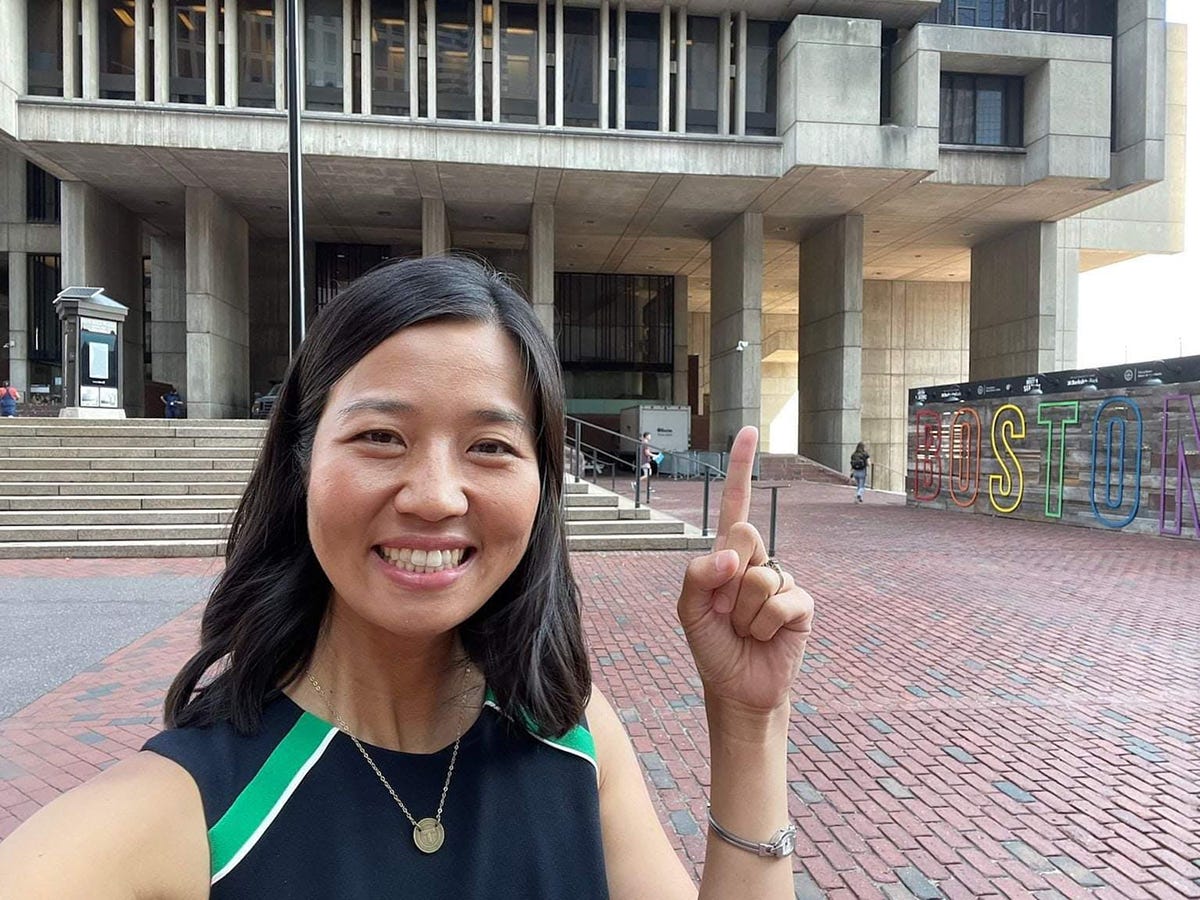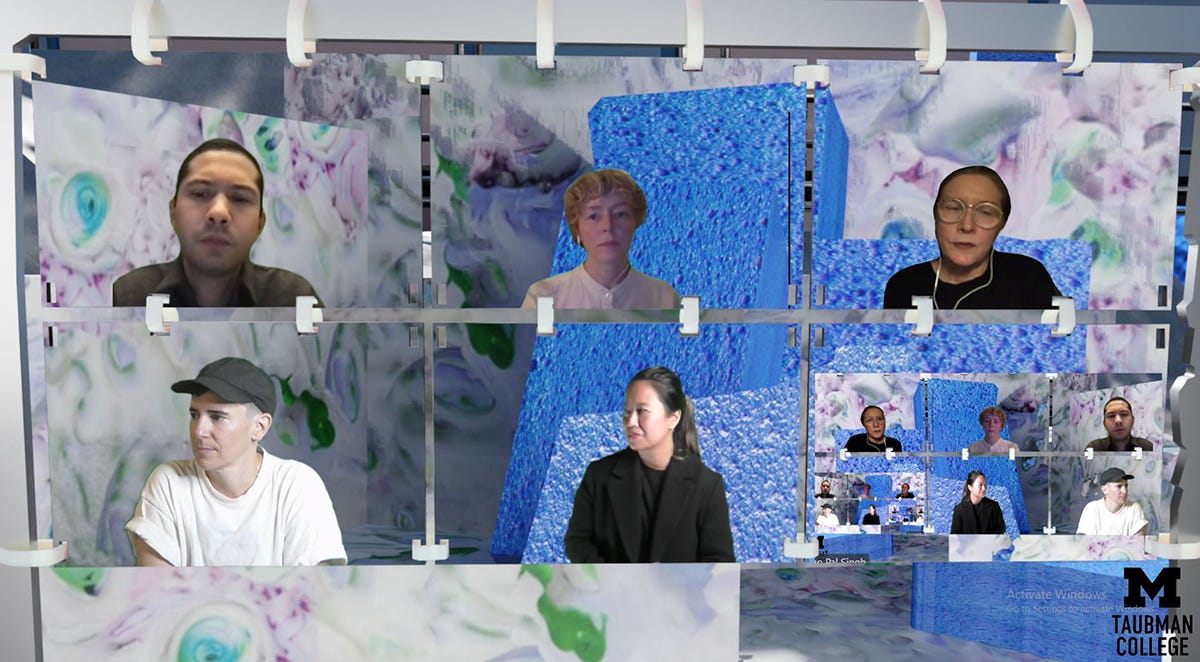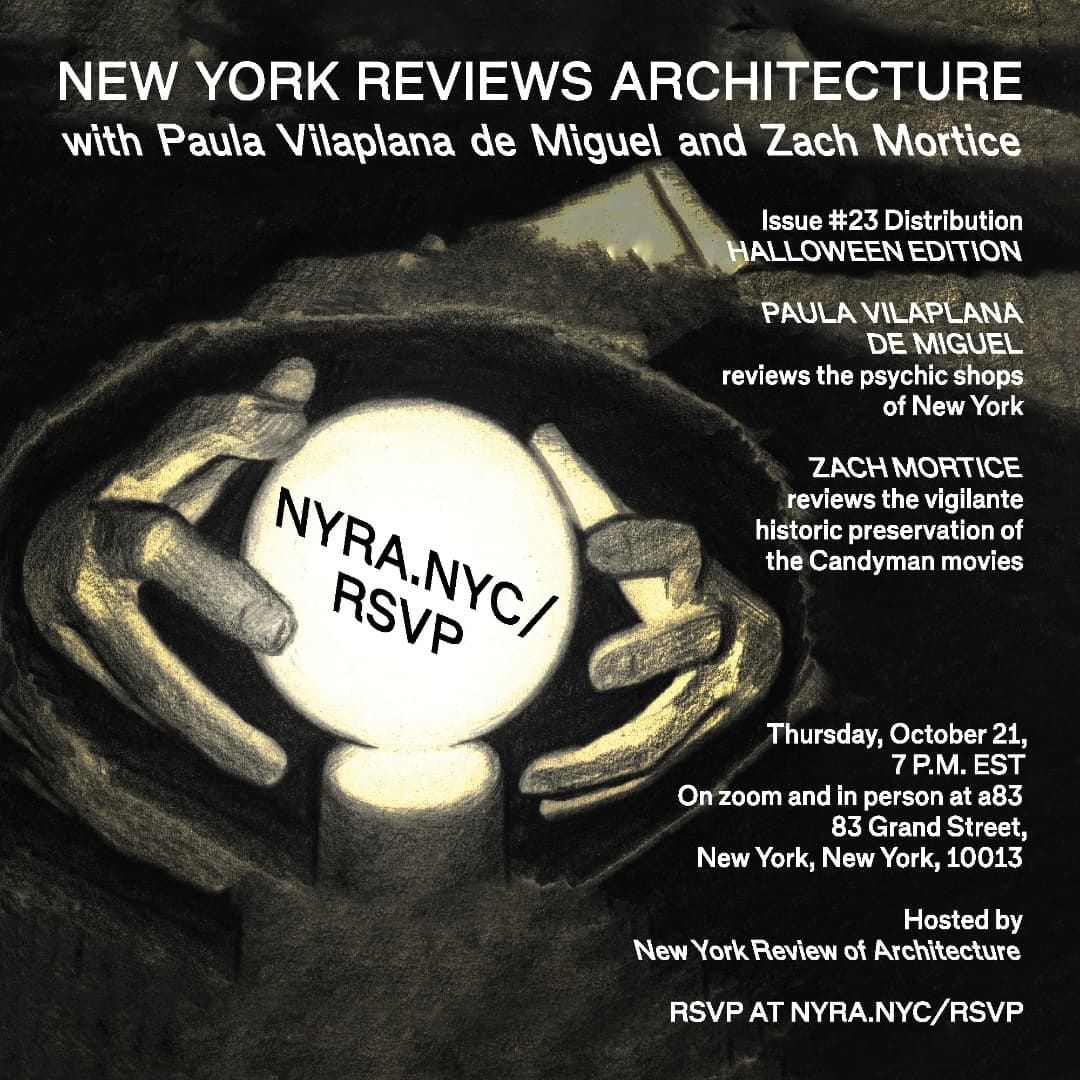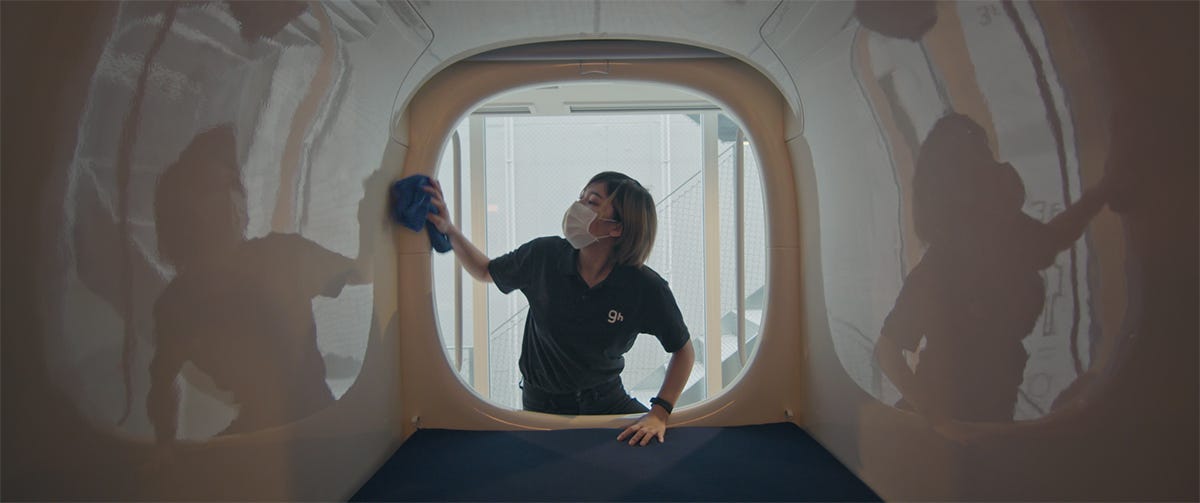S K Y L I N E | 41 | All Killer No Filler
An interview with Michelle Wu. Plus: a film, two symposia, a lecture, a tour, and more.
Welcome! If someone forwarded you SKYLINE, sign up here to receive it weekly.
Hi—a lot going on these days. And: lots to read—just keep scrolling…
NIMBLE, ACCOUNTABLE, TANGIBLE: AN INTERVIEW WITH MICHELLE WU

On August 27, Boston mayoral candidate Michelle Wu gave an Instagram Live tour of a building she loves: Boston City Hall. Wu is one of two remaining candidates in this year’s tight Boston mayoral race and is running on one of the most progressive platforms in the city’s history. As City Councilor At-Large, Wu champions ideas that, once considered out-of-reach, are serious proposals—including fare free public transit, bringing back rent control, abolishing the Boston Planning and Development Agency (BPDA), defunding the police, and ushering in a Green New Deal.
Wu’s mayoral run takes place in the midst of a reckoning about the city’s housing crisis and racial wealth gap. Between 2007-17, home prices in the city rose 61%. A recent report from the US Department of Housing showed that the average rental cost for a one-bedroom apartment in Boston is $2,880. Skyrocketing housing prices have forced thousands of predominantly non-white and working-class people to remain in a constant state of precarity. Things get worse when considering wealth distribution: today in Boston, the median net worth of white households is $247,500; for Black households, it’s $8.
Part of this can be traced to the removal of rent control in 1994; evictions and rent increases followed, as chronicled by Matthew L. Schuerman in Newcomers: Gentrification and Its Discontents. For Wu, bringing back rent control, introducing fare free public transit, defunding the police, rethinking development models, and taking a new regional approach to the housing crisis are all ways to reverse this trajectory. Systemic problems demand systemic solutions. These strategies are essential when repairing the damage that has been consistently inflicted on Boston’s non-white and working-class residents.
These big ideas are easier said than done, however. Over the past decade, Wu has gradually established her platform to attract a broad audience. Thanks to a large coalition of activists, community groups, and representatives, ideas such as rent control in Boston are back on the table.
Wu faces Councilor Anissa Essaibi George in the race for Boston’s next mayor. The General Election takes place on November 2; early voting begins on October 23 and runs through October 29.
I spoke with Wu via Zoom to talk about why she loves Boston City Hall and her plans for the city’s future. —Dan Jonas Roche
Dan Jonas Roche: What prompted you to give an Instagram Live tour of Boston City Hall?
Michelle Wu: I love the building that I have the honor to work in. I’ve realized over the years, however, that not everyone shares my deep love for not just what happens inside the building, but also the architecture.
The other mayoral candidates and I were in an interview with a local media outlet awhile back about our views of Boston City Hall where I said that I would be willing to fight anyone who disagrees with my assessment of how amazing and beautiful the building is or to take them on a tour. Unfortunately, there were way too many people who disagreed with me to do individual tours, so we decided to do it collectively over Instagram.
What do you think of the improvements being made to the building and plaza?
I’m excited to see more placemaking and improvements to the space around City Hall. It has always felt like we were falling short in our potential to draw people in and create the sense of community with government that our city deserves. With new landscaping and improvements, I’m excited to see people back out there again.
In 2019, you released your plan to Abolish the Boston Planning and Development Agency (BPDA). This would entail moving all BPDA functions, assets, and powers not enshrined in state law to city departments; ending all urban renewal areas (sixteen out of twenty-one of which are still active); and getting state approval to restore a City of Boston Planning Board for citywide master planning processes. What will the first one-hundred days of your mayoralty look like? What are the next steps?
This is an unusual year in the city for vacancy. The new administration will start not in January but on November 16, so the first one-hundred days begins a lot sooner than usual! Basically, the transition will be happening simultaneously to us hitting the ground running. Because there won’t be the chance for an extended transition, most of first hundred days will be about building out the team as we go and ensuring that we are prepared for major issues such as the ongoing pandemic, the imminent arrival of winter, and supporting our schools while we start to lay the foundation for the larger changes we will be implementing starting the next year.
We’re hoping to have some staffing changes that would help oversee and guide this process including a Chief of Planning that would work with the agency on moving towards reforms.
What would the city’s relationship be with the suburbs outside of Boston? How do you plan on working with mayors outside of Boston to implement a vision for the region?
This is incredibly important. It's a big part of the reason why we have built a coalition for the campaign that extends beyond the City of Boston as well. We got a lot of questions early on about why we were announcing endorsements from so many elected officials outside the city who don’t officially represent the constituency and voters that I am looking to represent in the upcoming election. The reality is that our deepest challenges are regional: our housing crisis, transportation access, climate vulnerability, the opiate crisis, how we fund and support our schools. We need to have strong regional partnerships as well as collaboration across all levels of government.
What are the Green New Deal’s biggest implications for architects not just in Boston but across the country?
We are past the point of urgency to act on the climate crisis; there are stark reminders of that day after day and month after month. Whether it's intense storms and flooding that claims lives, or heat in our neighborhoods that threatens the health and safety of our residents, or air pollution that is holding back the potential for our young people and risking the community’s health.
It can seem like a big global international issue, but things can be improved by very tangible decisions about city government, design, and the built environment. We can’t just add “resiliency” as one more checkbox that we ask or think about. This goal should be guiding our efforts around planning, development, and zoning. This means connecting our systems so that we are prepared and resilient, as well as tapping into the potential to close the racial wealth gap through the enormous opportunity that climate change represents.
I’ve always been impressed with how you can propose radical ideas in a way that comes off as pragmatic and practical. What’s your strategy? How do you propose big ideas in a city that often feels like it's impossible to get anything done?
The beauty of city government is that we must be nimble, accountable, and tangible in the changes that we seek. All of these big issues—and the plans and solutions that we’re putting forward in response—are built on the day-to-day experiences of our residents. These details add up to how we care for our families, experience our city, and build community.
So, it's about meeting people where they are.
Exactly!
Read this interview in print in issue #23.
New York Reviews Architecture! Next Thursday.
Join us for our Issue #23 distribution:
PAULA VILAPLANA DE MIGUEL reviews the psychic shops of New York.
ZACH MORTICE reviews the vigilante historic preservation of the Candyman movies.
DISPATCHES
10/08—Which Came First: Sharing or the Affordability Crisis?
Architecture Film Festival Rotterdam
“[Living alone or together] is not a matter of lifestyle,” observed urbanist ARIE LENGKEEK at a panel following the world premiere of When We Live Alone, the second in a three-part documentary series produced by the Canadian Centre for Architecture, at the Architecture Film Festival Rotterdam. “I think this is something that is really political in the end: it’s really about who owns the city, who gets to define how we live in the city together, and who benefits from the choices that are made.”
The panelists discussed the documentary in the context of changing demographics and experimental forms of living in the Netherlands. Architect LISANNE RISSIK, a specialist in co-housing, explained that “more people on a smaller plot requires more open spaces in the city.” As the space of the home shrinks and people engage in co-habitation, the city’s public spaces must step in and fill in the gap. Rissik cautioned, however, that some forms of collective living may reflect the economic reality that other types of housing are increasingly unaffordable. As Lengkeek further observed, “[the documentary presents] a portrait of what happens if cities are only a place of consumption.” When the city assumes the role of extending the domestic sphere (whether via a capsule hotel, an internet cafe, or a place to eat), it is often offered as a space of consumption. “I want us to produce urbanity,” said Lengkeek, “not just consume it.” — Sebastián López Cardozo
10/08–10/10—Black Matter Yields Alternate Futures
Black in Design Conference, Harvard GSD
Black Matter, the Black in Design Conference 2021 (BiD) organized by Harvard GSD’s African American Student Union, included keynotes by MPHO MATSIPA and LESLEY LOKKO, a series of panels, participatory workshops, and passive programming.
As students, we’re studying to become practitioners in fields where many of our counterparts may not look like us or understand our cultural and sociopolitical experiences. Spaces like BiD give us a place to complicate what we learn in our coursework while also dreaming of alternate futures where new realities and typologies can exist. BiD provided a welcome time to hear from practitioners across the diaspora and be inspired by their work, life experiences, and insights. For example: in Matsipa’s lecture, Black hair and the space it occupies was a welcome way to talk about the Black experience and its spatial dimensions. Although the conference was held virtually, it was still remarkable to be in community with hundreds of other African diasporic practitioners. We’re excited to see the next iteration of BiD in 2023. —Tobi Fagbule & Whytne Stevens
10/08 & 10/09—All Commodities Are Haunted
postcommodities…architecture after stuff symposium at Taubman

A digital tarp blowing in a simulated breeze; a serene-but-desolate industrial backdrop filled with muted, bitmapped objects; and piles and piles of digital refuse artifacts modeled in approximation of industrial waste—this was the digital scenography for postcommodities… architecture after stuff, a symposium held at the University of Michigan Taubman College of Architecture and Planning.
Assistant Professor LAIDA AGUIRRE of Stock-a-Studio invited a host of speakers to discuss their respective projects as they relate to “stuff.” On Friday evening, MICHAEL WANG, NICHOLAS KORODY, HEATHER DAVIS, and KELLER EASTERLING presented, followed by a Q+A with ANN LUI of Future Firm; during the day on Saturday, Postnatural Studies Institute, JAFFER KOLB of New Affiliates, SEETAL SOLANKI, SOFIA PIA BELENKI, and JACK HALBERSTAM shared, followed by a Q+A with MEREDITH MILLER.
Each presenter re-imagined positive afterlives for the messy things left behind by late-stage capitalism. They celebrated aesthetic qualities connected to disrepair, discomfort, decay, natural life cycles, the frayed edges of things, and the lumpy, which was warmly described by Kolb as “the grotesque.” Here, being grotesque means earnestly engaging with and celebrating the realities of matter. This happens through the reuse or destruction of objects.
The symposium took place in a hybrid format, so in its virtual variant “the grotesque” was experienced through the dystopian digi-scape of rubble and seemingly forgotten industrial objects, among which the speakers and their slides appear. This landscape was generated by a production team of Taubman-connected specialists: ANA TANG, LEAH WULFMAN, ISHAN PAL, and DELANEY MCCRANEY.
For Aguirre, an aspect of time is key, as they’re “constantly trying to make thing that are temporary more durable and things that are durable more temporary.” This entails finding a middle ground for how long things last in the world. —Charles Weak
10/11—Elephant World
Non-human Centered Architecture with Boonserm Premthada & Andrés Jaque, GSAPP
BOONSERM PREMTHADA, Principal at Bangkok Project Studio, lectured virtually as part of the Columbia GSAPP Dean’s Lecture Series. The presentation, titled “Non-Human Centered Architecture,” focused on Premthada’s recently completed elephant study center in Surin, Thailand. The project “takes a non-human centered approach that exemplifies ‘humanity’ by showing ‘empathy’ for elephants.”
Careful studies of the size, smell, and gait of elephants resulted in thoughtful details, such as concrete column footings specifically textured for the elephants to scratch up against or the use of grade and material changes to delineate spaces for elephants and humans. In the following conversation with ANDRÉS JAQUE, questions of standard subjects and communication arose—for example: "How does the process change when you’re designing for animals who can’t tell you what they want using words?”
At the scale of people, the center aims to revitalize the local economy, which faces resource depletion, poor elephant health, and, as a result, low elephant keeper wages. By valuing spaces for elephants, the cycle stands to be reversed. Premthada’s approach also attempts to “empower the people of Surin” and specifically engages the local Kui people as artisans in the construction of the project. Premthada’s architecture skillfully shapes space using considered natural light, tactile materiality, and a playful space-planning strategy. As he puts it, “Only 50% of the design is done by me; the rest is fulfilled by nature.” —Eddie Palka
10/14—Archtoberfest in Boerum Hill
If New York City goes into another COVID-19 lockdown, the occupants of 58 Saint Marks (designed by INC Architecture & Design and built and owned by Avdoo & Partners) will be sitting pretty—both in the metaphorical sense and in the literal sense.
There are so many spaces to sit in this Boerum Hill condominium building, which will be TCO-ready by December and already has 60% of its units spoken for. Of course one could say that about almost any of the creative- and leisure-class-oriented, mixed-use buildings cropping up across the City’s boroughs, but 58 Saint Marks draws directly from the grand brownstones surrounding it so the emphasis on sitting feels especially apparent. There is a parlor. A club room. An interior park. A library. A rooftop lounge. A garden. And a meditation room, where residents may further hone their skill at sitting. Not to mention that nearly 80% of the 100 residences have private, outdoor access. An enviable situation in normal times, but in COVID-world, access to outdoor space is the quintessence of luxury. —Anna Gibertini
EYES THAT SAW [SKYLINE]
(most clicked links from Skyline 40)
Last week, readers were quick to click on Curbed’s coverage of Alejandro Zaera-Polo’s meltdown at Princeton and photos of the new lobby of 550 Madison Avenue.
IN THE NEWS…
…Norman cashes out: Foster + Partners has sold a “significant interest” in the company to a Canadian private investment firm, which will replace Foster himself as the largest shareholder.
…Denizens of Twitter cried out against the forthcoming demolition of the Hotel Pennsylvania, to be replaced by a supertall PENN15 designed by Foster + Partners.
…New York City approved mass timber! CLT buildings up to eighty-five feet tall are now allowed in all five boroughs (read Chris Gardner’s podium piece on the backstory, here).
…Defector weighs in on Alejandro Zaera-Polo’s must-see TV deluge of grievances. As does Eva Hagberg in The Architect’s Newspaper.
…Archtober continues with in-person building tours around the city. NYRA is a media partner with Archtober. Want to cover an event? Write us!
DATELINE
The week ahead…
Friday, 10/15
Brownsville: Building in Place with Genese Morgan, Taurean C. Lewis, Ifeoma Ebo
1:00 PM | GSAPP
Saturday, 10/16
On the Duty and Power of Architectural Criticism/Session 3: Criticism and its Effects with Ruth Verde Zein (keynote), Jasna Galjer, Konstantinos Petrakos, Morten Birk Jørgensen, Carolina Chaves (Session chairs Hélène Jannière and Wilfried Wang)
9:00 AM | UT Austin School of Architecture
Kahn 120: Louis Kahn as a Teacher/ Conversation with Charles E. Dagit with Charles E. Dagit, Jr., Neeme Raud
12:00 PM | Consulate General of Estonia, Scandinavia House, Louis Kahn Estonia Foundation
Kahn 120: World Premiere of Maria Faust’s MO(NU)MENT with Maria Faust, Sam Kulik, Dan Peck
3:00 PM | Consulate General of Estonia, Scandinavia House, Louis Kahn Estonia Foundation
Kahn 120: Kahn Club with Arne Maasik, Rein Vainküla, Maria Faust
6:00PM | Consulate General of Estonia, Scandinavia House, Louis Kahn Estonia Foundation
Sunday, 10/17
On the Duty and Power of Architectural Criticism/Session 4: Explicit Criticism with Philippa Tumubweinee (keynote); Lynnette Widder; Alexandra Staug; Błażej Ciarkowski; Özlem Erdoğdu Erkarslan, Burak Altınışık, and Batu Kepekçioğlu (Session chairs Şengül Öymen Gür and and Fernando Diez)
9:00 AM | UT Austin School of Architecture
Monday, 10/18
Fall 2021 Sciame Lecture Series: Pushing Boundaries: An Architect's Journey with Neera Adarkar
12:30 PM | CCNY Spitzer School of Architecture
MAIO with Guillermo López, Anna Puigjaner, Maria Charneco, Alfredo Lérida, Amale Andraos
6:00 PM | GSAPP
Tuesday, 10/19
Margaret McCurry Lectureship in the Design Arts: Indigenous Urbanism with Jade Kake
6:30 PM | Harvard GSD
Wednesday, 10/20
Kenzo Tange Lecture with Emanuel Christ, Christoph Gantenbein, Kersten Geers, David Van Severen, Jeannette Kuo
12:00 PM | Harvard GSD
Baumer Series with J.T. Roane
5:30 PM | Ohio State University Knowlton School of Architecture
Lecture with Jennifer Newsom, Tom Carruthers, Dream The Combine
8:00 PM | CCA Architecture Division
The thread that leads to the word with Alison Saar
10:00 PM | SCI-Arc
Thursday, 10/21
Kiruna Forever: Relocating a City in Territories of Extraction with Carlos Mínguez Carrasco
1:00 PM | GSAPP
Joseph Choma & Maya Hayuk
6:00 PM | MIT
Out for a Walk in the Middle Voice with Jane Bennett
6:30 PM | Harvard GSD
New York Reviews Architecture Issue #23 Distribution with Paula Vilaplana de Miguel, Zach Mortice
7:00 PM | New York Review of Architecture
Friday, 10/22
Liz Gálvez + Estefanía Barajas: Houston Design Research Grant Lectures
1:00 PM | Rice Architecture/Rice Design Alliance
For the complete list and future weeks, visit: nyra.nyc/events
Have an event we missed? Submit the details here.
LETTERS TO THE EDITOR
Would you like to share your thoughts? Please write to us. Simply reply to this e-mail or write to us at editor@nyra.nyc.
Four desk editors run NYRA: Alex Klimoski, Phillip Denny, Carolyn Bailey & Nicolas Kemper (who also serves as the publisher). They rotate duties each month.
To pitch us an article or ask us a question, write to us at: editor@nyra.nyc.
For their support, we would like to thank the Graham Foundation and our issue sponsors, Tod Williams Billie Tsien Architects and Thomas Phifer.
To support our contributors and receive the Review by post, subscribe here.





